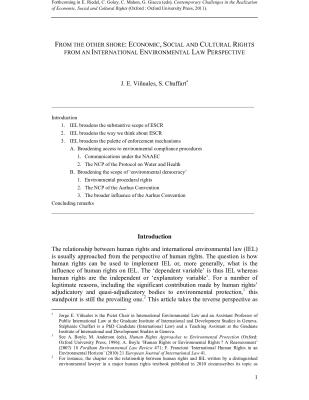The relationship between human rights and international environmental law (IEL) is usually approached from the perspective of human rights. The question is how human rights can be used to implement IEL or, more generally, what is the influence of human rights on IEL. The ‘dependent variable’ is thus IEL whereas human rights are the independent or ‘explanatory variable’. For a number of legitimate reasons, including the significant contribution made by human rights’ adjudicatory and quasi-adjudicatory bodies to environmental protection,1 this standpoint is still the prevailing one.2 This article takes the reverse perspective as its starting point. We focus indeed on how IEL can help implement human rights obligations. Conceptually, such an approach would look at human rights in general, without distinguishing between, on the one hand, civil and political rights (CPR) and, on the other hand, economic, social and cultural rights (ESCR). However, given the specific focus of the present volume, we concentrate on how IEL influences (or could be used to influence) the implementation of ESCR, referring to CPR only incidentally when this appears useful to illustrate our reasoning. The conclusion that we reach is, admittedly, no surprise to an audience specialised in human rights: the impact of IEL is, essentially, to broaden the scope of human rights, and particularly of ESCR, in a variety of ways. 3 Perhaps more interesting is how this broadening takes place. There are three main avenues through which this happens: IEL broadens the substantive scope of ESCR (I); IEL broadens the way in which we think about ESCR (II); and IEL broadens the palette of enforcement mechanisms available in connection with ESCR (III).



